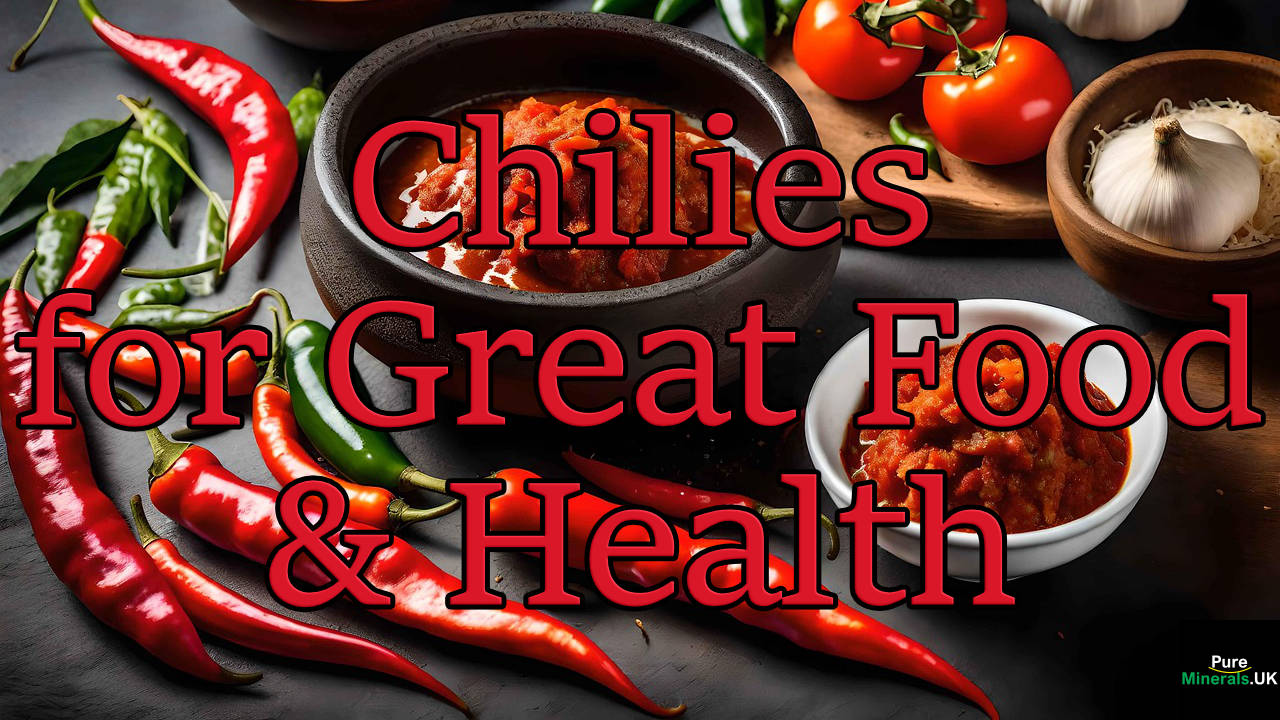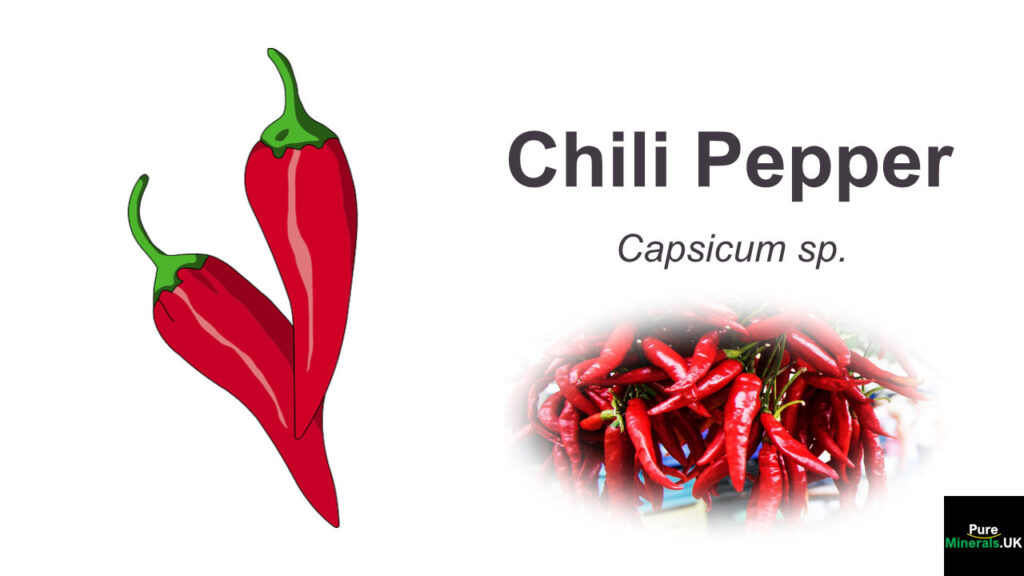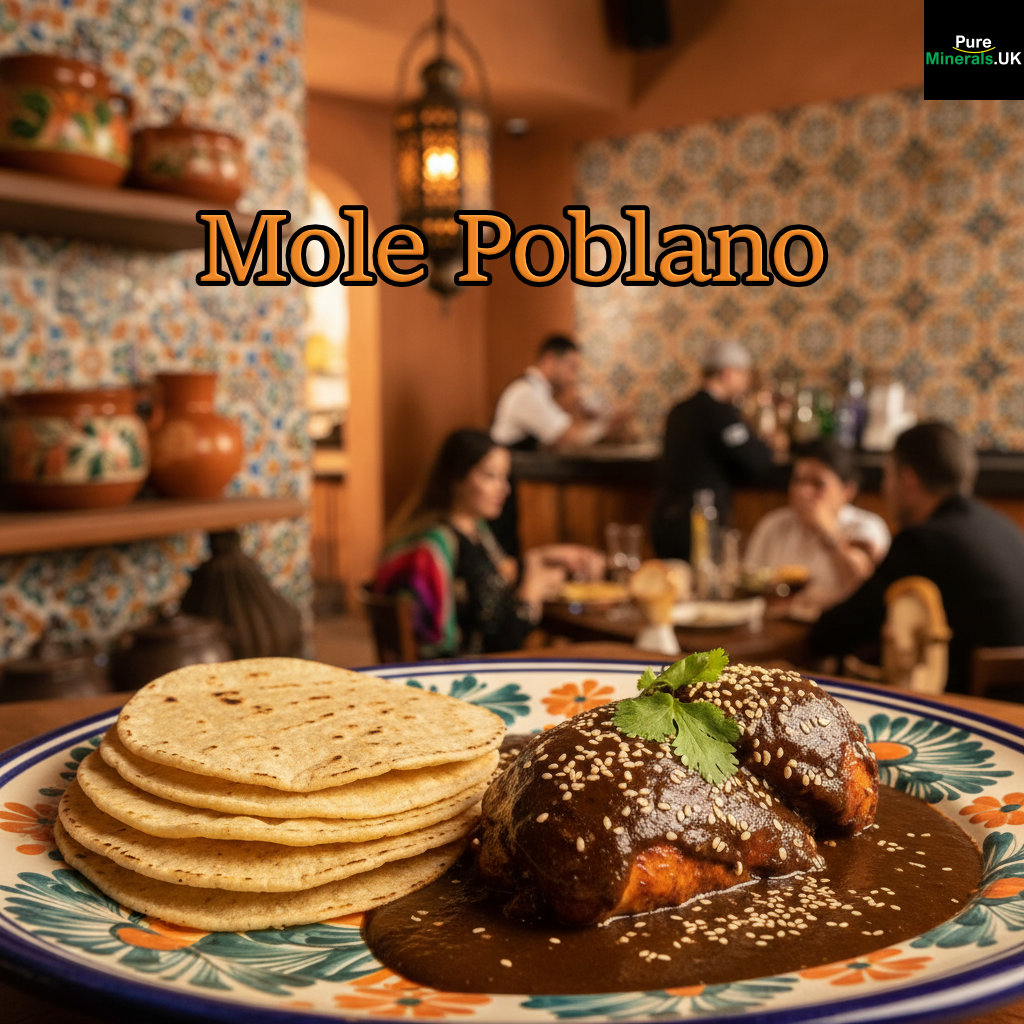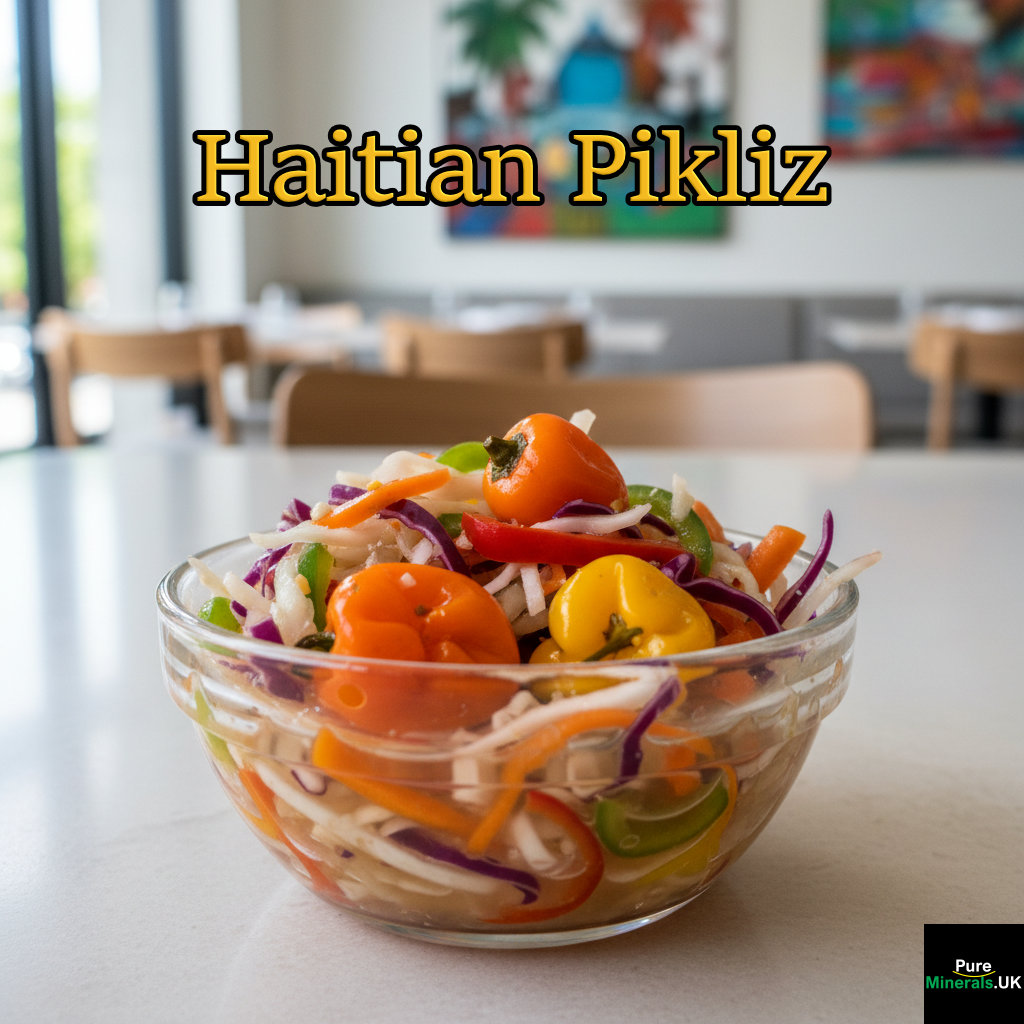
Key Takeaways
- Chilies contain capsaicin, which can boost metabolism by up to 5% and increase fat burning by up to 16%, making them valuable for weight management strategies.
- Regular consumption of chilies is associated with lower risks of cardiovascular diseases through improved blood vessel function and reduced inflammation.
- Chilies are packed with vitamins A, C, and B6, along with minerals like potassium and iron that support immune function and overall health.
- Capsaicin in chilies has natural pain-relieving properties that are increasingly used in topical treatments for arthritis and neuropathic pain.
- Adding chilies to your diet can be as simple as incorporating them into breakfast eggs, lunchtime soups, or evening meals for both flavor enhancement and health benefits.
Fire up your taste buds and your health with nature’s spicy gift. Chili peppers have been used for thousands of years not just as flavor enhancers, but as powerful medicinal tools. Today’s research is confirming what traditional healers have known for centuries – these colorful peppers pack a serious punch when it comes to health benefits. SpiceWorld notes that incorporating chilies into your regular diet can significantly improve various aspects of your wellbeing while adding incredible depth to your culinary creations.
From boosting metabolism to fighting inflammation, chilies deserve a prominent place in both your spice rack and wellness routine. Let’s explore the remarkable ways these fiery fruits can transform your health while delighting your palate with their distinctive heat and complex flavors.
The Hidden Nutritional Power of Chili Peppers

Updated on November 1, 2025 — we’ve added fresh insights on using Chilies in everyday cooking and nutrition.
Beyond their fiery personality, chilies are nutritional powerhouses that offer an impressive array of vitamins, minerals, and beneficial compounds. Despite their small size, these vibrant peppers deliver a concentrated dose of nutrients that support multiple body systems. Their rich nutritional profile makes them a valuable addition to any diet focused on enhancing overall health.
Capsaicin: The Active Compound Behind Chili’s Magic
The star player in chilies’ health-promoting arsenal is capsaicin, the compound responsible for their characteristic heat. This remarkable alkaloid binds to receptors in our mouth and body, creating the burning sensation we associate with spicy food. What’s fascinating is that capsaicin doesn’t actually cause physical damage – it simply triggers pain receptors in a way that makes us think we’re experiencing heat. This same mechanism is behind many of the therapeutic benefits chilies offer, from pain relief to metabolic enhancements.
Essential Vitamins and Minerals in Chilies
Chilies are surprisingly rich in essential nutrients that support overall health. A single tablespoon of red chili pepper contains nearly 9% of your daily vitamin A needs, crucial for vision and immune function. They’re also exceptionally high in vitamin C – a 100g serving of fresh chilies can provide over 100% of your daily requirement, which is more than citrus fruits like oranges. Additionally, chilies contain significant amounts of vitamin B6, folate, potassium, and copper. Learn more about the benefits of chili peppers.
The nutritional content varies between chili varieties, with red chilies generally offering more vitamin A and C than green varieties. Even dried chilies retain much of their nutritional value, making them a convenient year-round option for health-conscious cooks seeking both flavor and function from their ingredients.
- Vitamin C: 100g of fresh chilies can contain up to 240% of the daily requirements
- Vitamin A: Important for vision, immune function, and cell growth
- B Vitamins: Including B6, crucial for brain development and function
- Potassium: Helps regulate fluid balance and muscle contractions
- Iron: Essential for red blood cell production and oxygen transport
Ready to feel your absolute best? Unlock vibrant, natural energy and nourish every cell in your body with the power of our 16 essential vitamins and 74+ pure plant-derived minerals – much more than in chili peppers. Discover the difference today – visit our shop page.
Antioxidant Properties That Fight Inflammation
Chilies are packed with antioxidants that combat oxidative stress and inflammation throughout the body. These protective compounds, including flavonoids and carotenoids, help neutralize harmful free radicals that can damage cells and contribute to chronic diseases. The vibrant red, yellow, and orange colors of chilies are visual indicators of their rich carotenoid content – particularly beta-carotene and lutein, which support eye health and reduce inflammation.
Metabolic Benefits That Boost Your Health
One of the most studied aspects of chilies is their remarkable influence on human metabolism. These fiery fruits can literally heat your body’s engine, helping you burn calories more efficiently while potentially supporting weight management goals. Their metabolic benefits extend beyond simple calorie burning to include positive effects on blood sugar regulation and fat metabolism.
How Chilies Help Burn Calories
The capsaicin in chilies triggers a temporary increase in body temperature and metabolic rate through a process called thermogenesis. Research has shown that consuming chilies can boost metabolism by approximately 5% and fat burning by up to 16%. This metabolic enhancement is relatively modest but cumulative – regular consumption as part of a balanced diet may contribute to better weight management over time. The beauty of this effect is that it works passively, requiring no additional effort beyond incorporating these flavorful peppers into your meals. For more on how different spices can affect your health, you might explore the benefits of cardamom as well.
Blood Sugar Regulation Properties
Beyond their metabolic-boosting properties, chilies show promising effects on blood glucose control. Regular consumption may help stabilize blood sugar levels by improving insulin sensitivity – a crucial factor for those managing or at risk for type 2 diabetes. Studies suggest that capsaicin activates the transient receptor potential vanilloid 1 (TRPV1) channels, which may help reduce insulin resistance and improve glucose tolerance.
What makes this benefit particularly valuable is that it can be achieved through culinary doses rather than medicinal supplements. Adding fresh or dried chilies to meals, especially those high in carbohydrates, may help moderate the post-meal blood sugar spike that can contribute to insulin resistance over time. This represents a delicious way to support metabolic health through everyday food choices.
Effects on Cholesterol Levels
Preliminary research indicates that regular chili consumption may have favorable effects on blood lipid profiles. Capsaicin appears to help reduce LDL (low-density lipoprotein) cholesterol – often called “bad” cholesterol – while potentially increasing HDL (high-density lipoprotein) or “good” cholesterol. These effects, while modest, could contribute to better cardiovascular health when combined with other heart-healthy dietary practices.
Potential Weight Management Support
Chilies offer multiple mechanisms that may support weight management efforts. Beyond increasing caloric expenditure through thermogenesis, capsaicin appears to reduce appetite and increase feelings of fullness. Research suggests that adding chilies to meals can lead to consuming fewer calories throughout the day. This effect may be particularly pronounced when chilies are included in breakfast, potentially reducing calorie intake at subsequent meals.
Additionally, chilies may influence fat oxidation – the process by which stored fat is broken down and used for energy. Regular consumption might help shift the body’s preference toward burning fat rather than carbohydrates, which could support long-term weight management strategies. When combined with a balanced diet and regular exercise, chilies can be a flavorful addition to a comprehensive approach to maintaining healthy body composition. For more on how different foods can affect metabolism, you might explore the benefits of chicory.
Heart and Circulation Advantages
The cardiovascular benefits of chilies are among their most promising health attributes. From improving blood flow to supporting healthy blood pressure, these spicy fruits offer multiple mechanisms that contribute to heart health. The combined effects of their active compounds and rich nutrient profile make them valuable allies for cardiovascular wellness.
Research increasingly suggests that cultures with higher chili consumption often demonstrate lower rates of heart disease, though multiple dietary and lifestyle factors certainly contribute to this correlation. What’s clear is that the bioactive compounds in chilies interact with various cardiovascular systems in beneficial ways that may help protect against heart-related conditions.
Blood Pressure Improvements
Capsaicin’s interaction with sensory neurons may promote vasodilation – the widening of blood vessels – which can contribute to healthier blood pressure levels. This effect appears to be mediated through the release of nitric oxide, a molecule that relaxes the inner muscles of blood vessels. Regular consumption of chilies has been associated with modest reductions in blood pressure in some studies, particularly in people with existing hypertension.
Reduced Risk of Cardiovascular Problems
Population studies indicate that regular chili consumers may experience lower risks of cardiovascular mortality. A large-scale study published in 2019 found that people who ate chilies at least four times per week had a 40% reduced risk of dying from a heart attack compared to those who rarely or never ate chilies. The anti-inflammatory and antioxidant properties of capsaicin may protect blood vessels from damage while improving blood flow and reducing clotting risk – all crucial factors in cardiovascular health.
Pain Management and Other Therapeutic Uses
One of capsaicin’s most well-established medical applications is in pain management. What initially seems counterintuitive – that a compound causing burning sensations could relieve pain – becomes fascinating when we understand its mechanism of action. Capsaicin’s interaction with pain receptors offers unique therapeutic potential that modern medicine continues to explore and utilize.
Natural Pain Relief Applications
Capsaicin works as an analgesic by first activating and then desensitizing the TRPV1 pain receptors in our body. When applied topically, it initially causes warming and sometimes burning sensations, but with continued use, it depletes substance P – a neurotransmitter that signals pain to the brain. This unique mechanism makes capsaicin-based creams and patches effective for various pain conditions, including arthritis, neuropathic pain, and post-herpetic neuralgia.
Medical-grade capsaicin preparations are now standard treatments for certain types of chronic pain, representing one of the most direct transitions of chili’s traditional medicinal uses into modern healthcare. What’s remarkable is that, unlike many pain medications, capsaicin typically doesn’t cause systemic side effects since it works locally where applied, making it a valuable option for long-term pain management strategies.
Digestive System Benefits
Despite the common misconception that spicy foods cause digestive distress, research suggests chilies may actually benefit gut health in several ways. Capsaicin stimulates digestive enzyme production, potentially improving the breakdown of food and nutrient absorption. It also appears to support the stomach’s defense against ulcers by stimulating mucus production and reducing the growth of H. pylori bacteria – the primary cause of peptic ulcers.
Traditional medicine systems have long used chilies to stimulate sluggish digestion and improve appetite. Modern research confirms that moderate consumption may indeed enhance digestive function, though individual tolerance varies significantly. For those without existing inflammatory gut conditions, incorporating chilies into meals can support digestive health while adding wonderful depth of flavor. For more insights on digestive health, you might find this chapter on digestive health interesting.
Respiratory Health Improvements
Chilies are natural decongestants, making them particularly valuable during cold and flu season. Capsaicin stimulates secretions that help clear mucus from your stuffy nose or congested lungs. Next time you’re feeling congested, try a spicy chili-infused soup or tea to experience this effect firsthand. The heat triggers an immediate response, thinning mucus and making it easier to expel. For more on natural remedies, explore our article on the root of all disease.
Beyond temporary relief, compounds in chilies have demonstrated antimicrobial properties against certain respiratory pathogens. Their high vitamin C content further supports immune function, potentially helping your body fight off respiratory infections more effectively. This combination of immune support and symptom relief makes chilies a valuable addition to your wellness toolkit during respiratory illness seasons.
Culinary Uses Across Global Cuisines
Chilies are integral to culinary traditions worldwide, with each culture developing unique ways to harness their heat and flavor. From the subtle warmth of paprika in Hungarian goulash to the intense fire of Thai bird chilies in som tam, these versatile peppers have shaped food identities across continents. Understanding the diverse culinary applications can inspire your own kitchen experiments while helping you appreciate the cultural significance behind different preparations.
Mexican Cuisine: Beyond Just Heat

Mexican cuisine offers perhaps the most sophisticated and varied use of chilies in the world. Rather than simply adding heat, Mexican cooking treats chilies as complex ingredients with distinct flavor profiles. Dried chilies like ancho, guajillo, and pasilla are often rehydrated and pureed into rich, complex sauces that showcase their fruity, earthy, or smoky qualities. Fresh chilies like jalapeños and serranos are incorporated raw, roasted, or pickled to add bright, fresh heat to everything from salsas to soups.
The tradition of making mole sauces exemplifies Mexico’s reverence for chilies, combining multiple varieties like ancho chiles, guajillo chiles, and pasilla chiles, with almonds, peanuts, sesame and pumpkin seeds, anise, black peppercorns, cloves, thyme, marjoram, bay leaves, cinnamon, Mexican chocolate, chicken stock, and white bread, corn tortillas, onion, garlic, tomatillos, and tomato to create deeply layered flavors that bear little resemblance to the one-dimensional heat many associate with chili peppers. These sophisticated techniques transform chili peppers from mere heat sources into the foundation of a rich culinary heritage worth exploring for both flavor and health benefits.
Asian Spice Traditions

Across Asia, chilies feature prominently in numerous regional cuisines, often balanced against sweet, sour, and umami flavors. Chinese Sichuan cuisine uses chilies alongside numbing Sichuan peppercorns to create the distinctive málà sensation, while Korean cuisine incorporates gochugaru (chili flakes) into the ubiquitous fermented condiment kimchi. In India, dried red chilies and chili powders are fundamental to countless curry preparations, while Thailand embraces the intense heat of bird’s eye chilies in both fresh and dried forms.
Mapo Tofu, pictured here, is a renowned Chinese dish originating from Sichuan Province, a region celebrated for its bold and intensely spiced cuisine. Central to its distinctive flavor profile is the Sichuan peppercorn, the province’s signature spice, which imparts not only a unique fragrance and taste but also a characteristic “numbing” sensation. This numbing quality serves to balance and enhance the fiery heat of Sichuan cuisine, allowing diners to better appreciate its complex, layered flavors. The name of the dish translates to “pockmarked grandma’s tofu.”
What’s particularly notable about Asian applications is how chilies are often used in conjunction with other health-promoting ingredients like ginger, garlic, turmeric, and fermented foods. This synergistic approach potentially amplifies the benefits of each component while creating balanced, satisfying flavors that have stood the test of time. For those new to cooking with chilies, Asian recipes offer excellent templates for incorporating heat in balanced, flavorful ways.
Mediterranean and Middle Eastern Applications

While often overshadowed by more intensely spicy cuisines, Mediterranean and Middle Eastern cooking incorporate chilies in distinctive ways. Aleppo pepper from Syria offers moderate heat with fruity, raisin-like notes, while Turkish Urfa biber has a smoky, almost chocolate-like quality. These regions often use chilies more as accent notes than dominant flavors, showcasing their versatility beyond pure heat.
North African harissa paste, like the above Muhmmara, combines chilies with aromatic spices, creating a versatile condiment that adds both heat and complex flavor to dishes. In these culinary traditions, chilies frequently appear alongside heart-healthy ingredients like olive oil, garlic, and legumes, creating dishes that align perfectly with the widely praised Mediterranean diet pattern. This integration demonstrates how chilies can enhance rather than overwhelm more subtle flavor profiles.
African and Caribbean Flavor Profiles

African cuisines feature chilies in numerous traditional dishes, from North African berbere spice blends to West African pepper soups. In the Caribbean, scotch bonnet peppers, like those in the above Haitian Pikliz dish, bring their distinctive fruity heat to jerk seasoning and pepper sauces. These culinary traditions often pair chilies with sweet tropical fruits, creating complex flavor combinations that balance heat with natural sweetness.
What’s remarkable about both African and Caribbean applications is how chilies are often used in preservation techniques, extending the shelf life of other foods in hot climates before refrigeration was available. This practical application highlights the antimicrobial properties of capsaicin while creating vibrant flavors that have become cultural signatures. Drawing inspiration from these traditions can help you discover new ways to incorporate beneficial chilies into your diet.
Choosing the Right Chilies for Your Needs
With thousands of chili varieties available worldwide, selecting the right ones for your culinary and health goals can seem overwhelming. Understanding the distinctions between varieties helps you make informed choices based on your heat tolerance, flavor preferences, and the specific benefits you’re seeking. From sweet, mild peppers to mouth-numbing super-hots, the world of chilies offers options for every palate and purpose.
Mild to Wild: Understanding the Heat Scale
The Scoville Heat Unit (SHU) scale provides a standardized measurement of chili pepper heat, ranging from zero for sweet bell peppers to over 2 million for the Carolina Reaper. While capsaicin concentration generally correlates with health benefits, even mild chilies offer valuable nutrients and moderate therapeutic effects. For beginners, jalapeños (2,500-8,000 SHU) or poblanos (1,000-2,000 SHU) provide a gentle introduction to beneficial heat without overwhelming the palate.
Medium-heat chilies like serranos (10,000-23,000 SHU) and cayennes (30,000-50,000 SHU) strike a balance between significant capsaicin content and culinary versatility. The extremely hot varieties—habaneros, ghost peppers, and beyond—pack substantial capsaicin but require careful handling and are best used in small amounts by those with established spice tolerance. Remember that heat level doesn’t necessarily correlate with flavor quality—each variety offers unique taste characteristics beyond its spiciness.
Best Chilies for Specific Health Benefits
Different chili varieties offer slightly different nutritional profiles that may be targeted toward specific health goals. Red chilies generally contain more vitamin A than green varieties, making them particularly beneficial for vision and immune health. Mature red jalapeños (often dried as chipotles) provide a good balance of moderate heat and high antioxidant content, making them excellent all-purpose health boosters.
For cardiovascular benefits, cayenne pepper has been specifically studied for its positive effects on circulation and blood pressure. If digestive support is your goal, milder varieties like Anaheim or Hungarian wax peppers may provide benefits without overwhelming sensitive systems. Remember that consistency is more important than variety—regular consumption of any chili type will likely deliver more benefits than occasional use of “optimal” varieties.
How to Select and Store Fresh Chilies
When selecting fresh chilies, look for firm, glossy specimens with vibrant color and unwrinkled skin. The stems should be fresh and green, indicating recent harvesting. Avoid chilies with soft spots, mold, or discoloration, as these indicate spoilage. Store unwashed fresh chilies in a paper bag in your refrigerator’s crisper drawer, where they’ll typically last 1-2 weeks, depending on freshness at purchase. For more tips on preserving freshness, consider reading about storing celery, which shares similar storage requirements.
For longer preservation, consider freezing whole chilies (no preparation needed), drying them in a dehydrator or low oven, or creating preserves like hot sauces and pickled peppers. Dried chilies can maintain their flavor and beneficial compounds for up to a year when stored in airtight containers in cool, dark locations. These preservation methods allow you to enjoy seasonal chilies year-round while maintaining much of their nutritional value and distinctive flavors.
Practical Ways to Add More Chilies to Your Diet
Incorporating more chilies into your daily meals doesn’t require radical diet changes or elaborate recipes. Simple, strategic additions can significantly increase your intake of these beneficial peppers while enhancing flavor. The key is finding approaches that match your taste preferences and cooking style so that chili consumption becomes a sustainable, enjoyable habit rather than a short-lived health kick.
1. Morning Kickstarters
Begin your day with a metabolic boost by adding minced jalapeño or serrano peppers to scrambled eggs or breakfast burritos. A dash of hot sauce on avocado toast or a pinch of cayenne in your morning smoothie can wake up both your taste buds and metabolism. For a gentler approach, try adding mild roasted green chilies to breakfast casseroles or incorporating a small amount of chili-infused oil as a finishing touch on savory breakfast bowls.
2. Lunchtime Boosters
Elevate your midday meals with strategic chili additions that provide energy without causing afternoon slumps. Add pickled jalapeños to sandwiches and wraps for flavor without overwhelming heat, or stir red pepper flakes into soups and stews for warmth that builds gradually. Chili-based condiments like sriracha or harissa can transform simple lunches into flavorful experiences with just a small amount, while chopped fresh chilies make excellent additions to salads and grain bowls for textural contrast and nutrient boosts.
3. Dinner Enhancers
Dinner offers perhaps the most versatile opportunities for incorporating chilies into your routine. Try stuffing poblano or bell peppers with protein-rich fillings for a complete meal, or add dried chilies to slow-cooked stews where they’ll infuse the dish with complex flavors. Chili-based marinades not only add flavor to proteins but may help reduce the formation of harmful compounds during high-heat cooking methods like grilling or roasting. For international inspiration, explore classics like Thai curries, Mexican enchiladas, or Indian vindaloo that showcase chilies as central ingredients rather than mere garnishes.
4. Healthy Snack Options
Satisfy between-meal hunger with nutritious chili-enhanced snacks that offer flavor satisfaction without empty calories. Sprinkle chili powder on fresh fruit like mango, pineapple, or watermelon for a sweet-heat contrast popular in many Latin American countries. Roasted nuts tossed with a light coating of chili-infused oil and sea salt provide protein and healthy fats alongside capsaicin benefits.
For something more substantial, try baked sweet potato wedges dusted with smoked paprika or traditional Mexican cucumber spears with chili and lime. Even popcorn can become a functional food when seasoned with nutritional yeast and cayenne for a savory, satisfying snack that supports metabolism without excessive calories or unhealthy fats. If you’re interested in exploring more about unique ingredients, check out the benefits of chicory in your diet.
5. Beverages with a Kick
Don’t overlook the potential to incorporate chilies into what you drink. A tiny pinch of cayenne can transform hot chocolate into a metabolism-boosting treat inspired by traditional Aztec chocolate preparations. Chili-infused waters – simply add a few slices of fresh chili to your water bottle – provide a subtle flavor that may help increase hydration through more frequent sipping. For special occasions, craft cocktails and mocktails featuring muddled fresh chilies or chili-infused simple syrups create memorable flavor experiences with functional benefits.
Morning tonics combining lemon juice, a touch of honey, and a small amount of cayenne in warm water have long been used as daily health rituals in many wellness traditions. These beverages offer gentle ways to acclimatize to chili heat while potentially supporting digestion and metabolism from the start of your day.
Precautions and Potential Side Effects
While chilies offer impressive health benefits, they aren’t appropriate for everyone in all circumstances. Understanding the potential downsides helps you make informed decisions about how to incorporate these powerful foods into your diet. Most adverse effects are temporary and manageable, but certain populations need to exercise particular caution.
The capsaicin that provides health benefits can also cause discomfort when consumed in excess or by sensitive individuals. Finding your personal balance point—where you gain benefits without unpleasant side effects—is key to a sustainable relationship with spicy foods. Starting with small amounts and gradually increasing your intake allows your body to adapt while minimizing adverse reactions.
Who Should Limit Chili Consumption
People with certain gastrointestinal conditions like irritable bowel syndrome, inflammatory bowel disease, or gastroesophageal reflux disease may find that chilies exacerbate their symptoms. If you have a history of these conditions, introduce chilies cautiously and in small amounts, preferably under a healthcare provider’s guidance. Those recovering from gastrointestinal surgery or dealing with active peptic ulcers should generally avoid chilies until healing is complete.
Individuals taking certain medications, particularly blood thinners like warfarin, should maintain consistent chili consumption rather than dramatically increasing or decreasing intake, as capsaicin may interact with these medications. Pregnant women can generally consume moderate amounts of chilies if they were part of their pre-pregnancy diet, but should avoid suddenly introducing large quantities of very spicy foods. When in doubt about your specific situation, consulting with a healthcare provider familiar with your medical history is always the wisest approach.
Safe Handling Tips
The capsaicin in chilies can cause significant skin and eye irritation, making proper handling techniques essential. Always wear food-safe gloves when cutting hot chilies, especially varieties above jalapeño on the heat scale. Avoid touching your face, eyes, or other sensitive areas while working with chilies, and wash your hands thoroughly with soap and cold water after handling (hot water can open pores and increase absorption of capsaicin).
When cooking with chilies, be aware that heated capsaicin can become airborne, potentially causing respiratory irritation. Ensure good kitchen ventilation when dry-roasting or frying chilies to prevent coughing fits or eye irritation. Store chilies, particularly dried varieties, in clearly labeled containers away from other spices to prevent accidental excessive use. These simple precautions help you enjoy the benefits of chilies while minimizing potential discomfort.
The Perfect Balance: Enjoying Chilies for Flavor and Health
The beauty of chilies lies in their dual role as both health-promoting foods and flavor-enhancing ingredients. Rather than viewing them purely as medicinal supplements or culinary accessories, embrace the integration of both aspects. The most sustainable approach to gaining benefits from chilies is finding preparations you genuinely enjoy, which naturally encourages regular consumption.
Whether you prefer the subtle warmth of paprika, the bright heat of fresh jalapeños, or the intense fire of habaneros, there’s a place for chilies in nearly every cuisine and dietary pattern. Let your personal preferences guide your exploration while remaining open to gradually expanding your spice tolerance for both culinary adventure and increased health benefits. For those seeking to enhance their well-being through natural food-based approaches, SpiceWorld offers premium chili products that combine traditional wisdom with modern quality standards.
Frequently Asked Questions
Below are answers to some common questions about incorporating chilies into your diet and lifestyle. These practical insights can help you navigate potential challenges while maximizing the benefits these remarkable peppers offer.
Can eating chilies help me lose weight?
Chilies can contribute to weight management efforts through several mechanisms, but they’re not magic bullets for weight loss. The capsaicin in chilies temporarily boosts metabolism and may increase fat oxidation, potentially burning an extra 50-100 calories per day with regular consumption. Perhaps more significantly, chilies appear to reduce appetite and increase feelings of fullness, which may naturally reduce calorie intake.
These effects are modest but meaningful when combined with other healthy habits. For best results, incorporate chilies into balanced meals rather than using them as standalone supplements. The metabolic boost is most pronounced in people who don’t regularly consume spicy foods, as the body may develop tolerance to these effects over time. If you’re interested in exploring other spices, consider learning about cardamom and its health benefits.
Consider chilies as one helpful tool in a comprehensive approach to weight management rather than a primary strategy. Their ability to enhance flavor without adding significant calories makes them particularly valuable for creating satisfying meals while maintaining a calorie deficit.
Weight Management Potential of Chilies
Research shows that regular consumption of chilies can:
- Increase metabolic rate by approximately 5%
- Boost fat oxidation by up to 16%
- Reduce appetite and calorie intake at subsequent meals
- Enhance the flavor of healthy foods without adding significant calories
These effects work best as part of an overall healthy eating pattern and active lifestyle.
Are dried chilies as beneficial as fresh ones?
Dried chilies retain many of the beneficial compounds found in fresh varieties, though there are some nutritional differences to consider. The drying process preserves capsaicin content well—in fact, it becomes more concentrated as water is removed. Antioxidant levels also remain relatively stable, with some studies suggesting certain antioxidant compounds may become more bioavailable after drying. However, heat-sensitive vitamins like vitamin C decrease significantly during the drying process.
- Capsaicin content: Preserved and concentrated in dried chilies
- Vitamin C: Significantly reduced in dried forms compared to fresh
- Flavor compounds: Often transformed, creating complex profiles not found in fresh chilies
- Antioxidants: Generally well-preserved, with some becoming more concentrated
- Shelf stability: Dramatically improved, allowing year-round consumption
Both forms have their place in a health-focused diet. Fresh chilies provide more vitamin C and bright, immediate heat, while dried varieties offer concentrated flavor, unique taste profiles, and convenience. Using a combination of both forms ensures you receive the full spectrum of nutritional benefits while enjoying diverse culinary applications.
From a practical standpoint, dried chilies allow you to maintain consistent consumption regardless of seasonal availability, supporting the regular intake that appears most beneficial for health outcomes. Their extended shelf life also reduces food waste, making them economical choices for health-conscious cooking.
How can I reduce the burning sensation after eating spicy food?
When chili heat becomes overwhelming, reach for dairy products first—milk, yogurt, or ice cream contain casein proteins that bind to capsaicin molecules, washing them away from pain receptors. Starchy foods like rice or bread can help absorb capsaicin oil, while acidic beverages like lemonade may partially neutralize the alkaline capsaicin. Avoid water, which merely spreads the oil-based capsaicin around your mouth, potentially intensifying the burn. For those building spice tolerance, gradually increasing consumption allows your body to adapt, reducing sensitivity to capsaicin over time without diminishing its health benefits.
Can chilies help with seasonal allergies?
Chilies may offer relief from seasonal allergy symptoms through their natural decongestant properties. Capsaicin stimulates secretions that help thin mucus, potentially clearing nasal passages clogged by allergic reactions. Additionally, the anti-inflammatory compounds in chilies might reduce the inflammatory response driving allergy symptoms.
While not a replacement for medical treatment of severe allergies, incorporating chilies into your diet during allergy season—particularly in hot soups or teas—may provide complementary relief alongside conventional approaches. Some people find that a spicy meal provides temporary but noticeable improvement in nasal breathing and reduced congestion when seasonal allergies strike.
Is it true that regular consumption of chilies builds tolerance to spice?
Yes, regular consumption of spicy foods definitely builds tolerance to capsaicin’s heat sensation. This adaptation occurs through several mechanisms, including decreased sensitivity of pain receptors and increased efficiency in breaking down capsaicin. What begins as intensely spicy can become pleasantly warming with consistent exposure over weeks or months. This biological adaptation allows people to gradually enjoy higher capsaicin doses without discomfort.
Importantly, developing heat tolerance doesn’t diminish the health benefits of chilies—your body still responds to capsaicin’s metabolic and anti-inflammatory effects even as your perception of its heat decreases. This makes building spice tolerance a worthwhile endeavor for those interested in the health aspects of chilies but initially sensitive to their heat.
